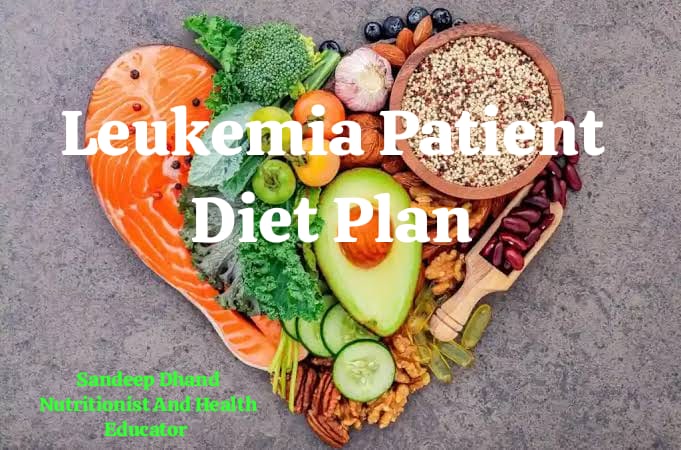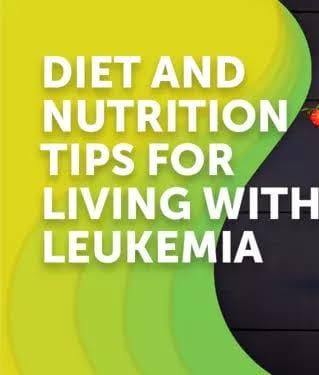Sandeep Dhand
Nutritionist And Health Educator
Leukemia is a type of blood cancer that affects the body’s ability to produce healthy blood cells. It starts in the bone marrow, where blood cells are made. This disease can be life-threatening if not treated on time, but with modern medical advancements, many people can live longer and healthier lives after treatment.
In this article, we will discuss leukemia in detail, using simple words to help you understand its causes, symptoms, and available treatments. We will also share a diet plan to support recovery and boost immunity.
What is Leukemia?

Leukemia is a type of cancer that affects the blood and bone marrow. In a healthy body, the bone marrow produces three main types of blood cells:
- Red blood cells (RBCs) – These carry oxygen to different parts of the body.
- White blood cells (WBCs) – These fight infections and protect the body from diseases.
- Platelets – These help in blood clotting to prevent excessive bleeding.
In leukemia, the body starts producing too many abnormal white blood cells, which do not function properly. These cells grow uncontrollably and crowd out healthy blood cells, leading to serious health problems.
Types of Leukemia
Leukemia can be classified into four main types:
- Acute Lymphoblastic Leukemia (ALL)
Common in children but can also affect adults.
Develops quickly and needs immediate treatment.
- Acute Myeloid Leukemia (AML)
Mostly affects older adults but can occur at any age.
Progresses rapidly and requires urgent treatment.
- Chronic Lymphocytic Leukemia (CLL)
Develops slowly and is common in older adults.
May not show symptoms for many years.
- Chronic Myeloid Leukemia (CML)
Progresses slowly at first but can become aggressive over time.
More common in adults.
Causes of Leukemia
Doctors do not always know what causes leukemia, but some factors increase the risk of developing the disease:
Genetic mutations – Changes in DNA can cause blood cells to become cancerous.
Radiation exposure – High levels of radiation, such as from nuclear accidents or radiation therapy, can increase risk.
Chemical exposure – Long-term exposure to harmful chemicals like benzene (found in gasoline) may contribute.
Smoking – Tobacco contains harmful chemicals that may increase leukemia risk.
Family history – If a close relative has leukemia, the chances of developing it are slightly higher.
Weak immune system – People with immune disorders or those taking immune-suppressing medicines may be at higher risk.
Symptoms of Leukemia
Leukemia symptoms can vary depending on the type and stage of the disease. Common symptoms include:
Extreme fatigue – Feeling weak and tired all the time.
Frequent infections – Getting sick more often due to weak immunity.
Easy bruising and bleeding – Small injuries may cause excessive bleeding.
Unexplained weight loss – Losing weight without trying.
Fever and night sweats – Experiencing fever without an infection.
Swollen lymph nodes – Lumps in the neck, armpits, or groin.
Bone pain – Pain or discomfort in bones and joints.
If you or someone you know has these symptoms for a long time, it is important to visit a doctor for proper diagnosis.
Diagnosis of Leukemia
Doctors use several tests to diagnose leukemia:
- Blood tests – A complete blood count (CBC) helps detect abnormal blood cell levels.
- Bone marrow biopsy – A small sample of bone marrow is taken to check for cancer cells.
- Genetic tests – Helps find specific mutations related to leukemia.
- Imaging tests – CT scans and MRIs help check if leukemia has spread to other parts of the body.
Treatment for Leukemia
Treatment for leukemia depends on the type, stage, and overall health of the patient. The main treatments include:
- Chemotherapy
The most common treatment.
Uses powerful drugs to kill cancer cells.
Can cause side effects like nausea, hair loss, and fatigue.
- Radiation Therapy
High-energy rays target and destroy cancer cells.
Used to shrink tumors or prepare for a bone marrow transplant.
- Bone Marrow Transplant
Replaces damaged bone marrow with healthy stem cells.
Can be done using a patient’s own cells or from a donor.
- Targeted Therapy
Uses medicines that attack specific cancer cells without harming healthy cells.
Fewer side effects compared to chemotherapy.
- Immunotherapy
Boosts the body’s immune system to fight leukemia.
New and promising treatment with fewer side effects.
Early detection and treatment can significantly improve survival chances.
Diet Plan for Leukemia Patients

A proper diet is essential for leukemia patients to maintain strength, recover from treatment, and improve overall health.
Foods to Eat
- Protein-Rich Foods
Chicken, fish, eggs, and lean meats
Lentils, beans, and tofu
Dairy products like yogurt and paneer
- Iron-Rich Foods (to prevent anemia)
Spinach, kale, and broccoli
Beetroot and pomegranate
Nuts and seeds (almonds, walnuts, flaxseeds)
- Fruits and Vegetables
Oranges, apples, bananas, and papaya (rich in vitamins)
Carrots, bell peppers, and tomatoes (rich in antioxidants)
- Healthy Fats
Olive oil, coconut oil, and ghee
Avocados and nuts for good fats
- Whole Grains
Brown rice, oats, and whole wheat bread
Quinoa and millets for extra nutrition
- Hydrating Drinks
Coconut water and fresh fruit juices
Herbal teas and soups
Plenty of water to flush out toxins
Foods to Avoid
Processed foods – Avoid packaged chips, biscuits, and fast food.
Sugary foods – Cakes, sweets, and soft drinks can weaken immunity.
Red meat – Hard to digest and may cause inflammation.
Alcohol and smoking – Damages cells and increases complications.
Unwashed or raw food – Can carry bacteria that may cause infections.
Daily Diet Plan for Leukemia Patients

Morning (7:00 AM – 8:00 AM)
A glass of warm water with lemon
A handful of soaked almonds and walnuts
Breakfast (9:00 AM – 10:00 AM)
Oats or dalia (porridge) with milk or yogurt
A fruit like banana or apple
Mid-Morning Snack (11:30 AM – 12:00 PM)
Fresh coconut water or homemade fruit juice
A handful of sunflower or pumpkin seeds
Lunch (1:00 PM – 2:00 PM)
Brown rice or chapati with dal (lentils)
A bowl of vegetable curry (spinach, carrots, broccoli)
A small bowl of curd (yogurt)
Evening Snack (4:00 PM – 5:00 PM)
Herbal tea with nuts or roasted makhana (fox nuts)
Dinner (7:00 PM – 8:00 PM)
Light khichdi or vegetable soup
A small salad with olive oil dressing
Before Bed (9:00 PM – 10:00 PM)
A glass of warm turmeric milk (haldi doodh)
Conclusion: Leukemia is a serious disease, but with early diagnosis and the right treatment, many people recover and lead normal lives. A healthy diet plays a crucial role in strengthening the immune system and supporting recovery.
If you or a loved one has leukemia, focus on nutritious foods, regular medical checkups, and a positive mindset. Consult a doctor or nutritionist for a personalized diet plan
